Article's Content
Many B2B brands use social proof throughout their website to influence prospects’ buying decisions.
Drift, for instance, uses case studies and customer logos on their homepage. Hubspot uses raw data to make a case for new users on its homepage. This is nothing new.
But ShipBob takes it to a whole new level.
They have over ten social proof variations on just their homepage, with over 200 other examples of social proof on almost every page on their website.
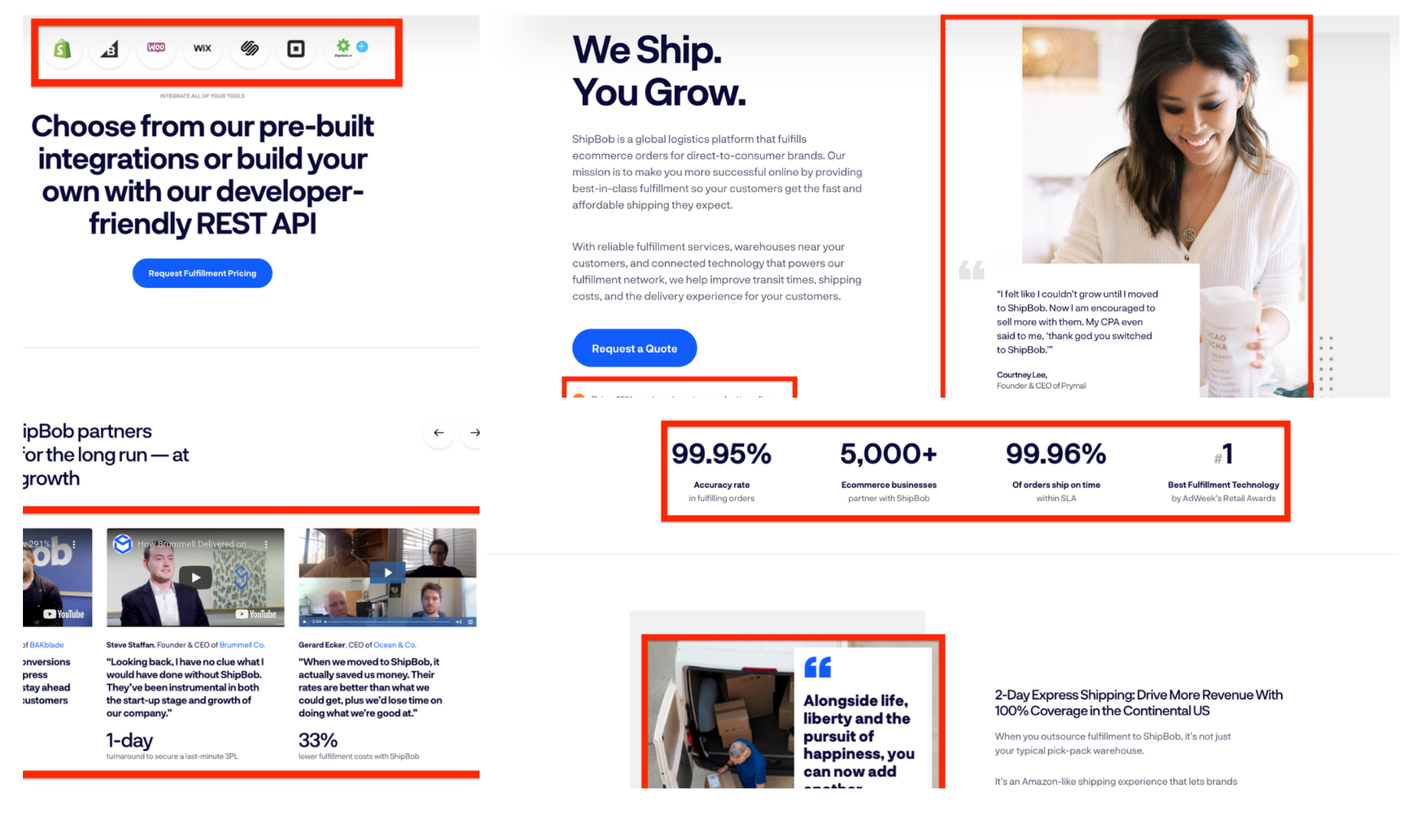
Everywhere you look on the company’s website, there are smiling faces, familiar brands, impressive stats, and positive, relatable stories waiting to move you further down the sales funnel.
The global logistics company created a replicable social proof formula that humanizes ShipBob’s technical process. And they use this formula all over their site, social media, and more.
As a result, prospects understand how the product helps e-commerce businesses achieve their goals and make informed buying decisions.
This formula has also contributed to ShipBob’s billion-dollar valuation and other successes they have recorded in seven years, including the 5000+ e-commerce businesses that trust them.
Want to Steal ShipBob’s Social Proof Strategy? Download this checklist!
By downloading this resource, you’ll also start receiving a few emails per week on B2B growth and content marketing
ShipBob’s Social Proof Formula
The ultimate goal of social proof is to inspire trust to influence buying decisions, drive sales, and boost conversions. No one is going to connect with a logistics process, but they sure will connect with Anastasia’s story:
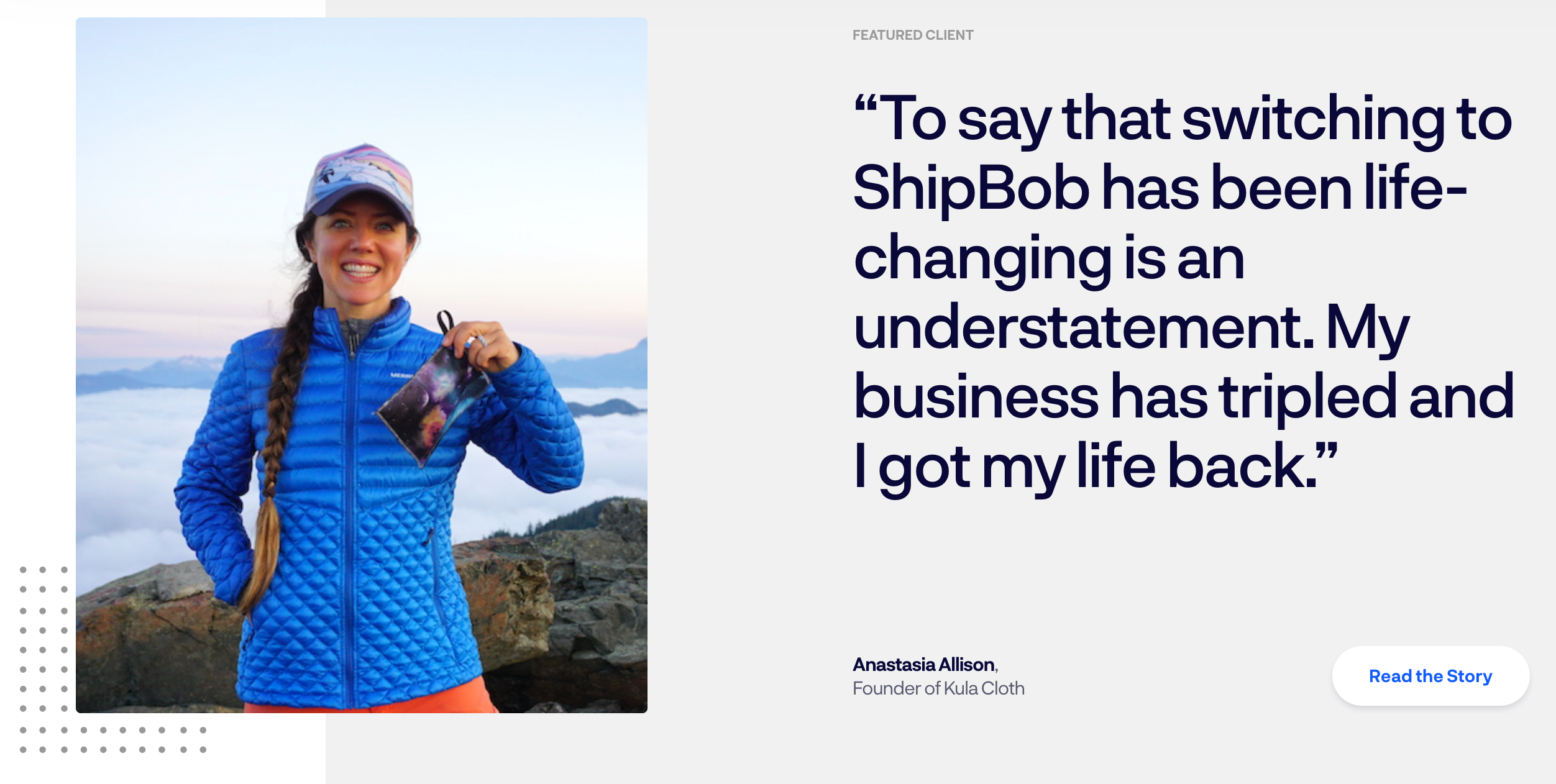
And we’ve got some stats to prove this:
- Testimonials can increase sales page conversions by 34%
- 93% of consumers say online reviews impact purchase decisions
- 2 out of 3 people say they’d be more likely to purchase after watching a video testimonial demonstrating how a business, product, or service had helped another person like them
That’s the first reason ShipBob relies so much on social proof: to establish an immediate emotional connection with prospects.
As you know, not all industries are created equal. Some are exciting and easy to explain to a new user. Take Adobe Photoshop, for instance. The homepage has zero social proof; instead, it highlights Photoshop’s many unique features:
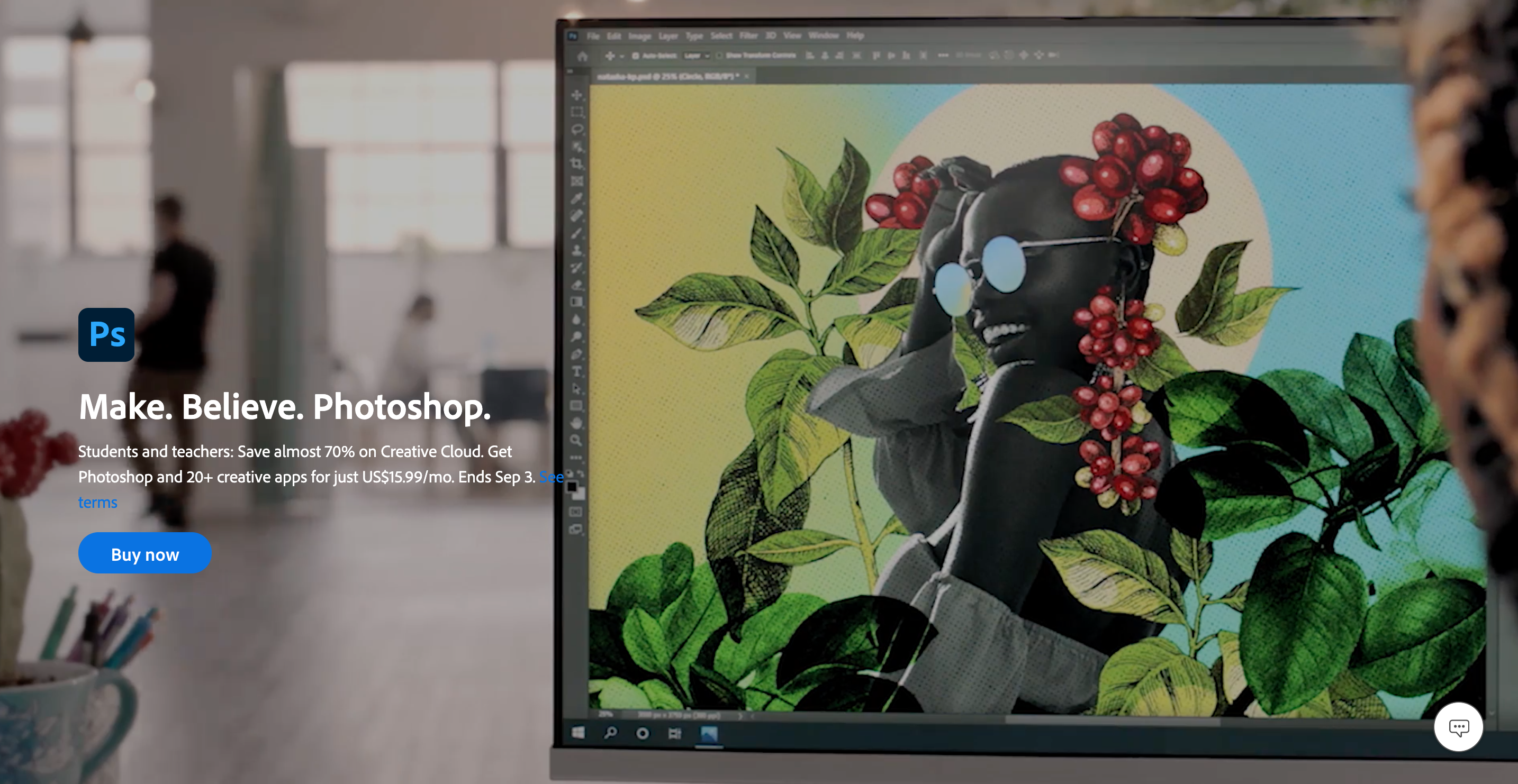
Adobe’s customer base will immediately understand how powerful the product is just by reading the features. ShipBob, on the other hand, is an excellent product in a less immediately appealing industry.
In technical industries like shipping and logistics, most company websites are heavy on technical industry terms and focus on product features that can easily overwhelm the user. A typical feature-heavy page looks pretty much like this formula:
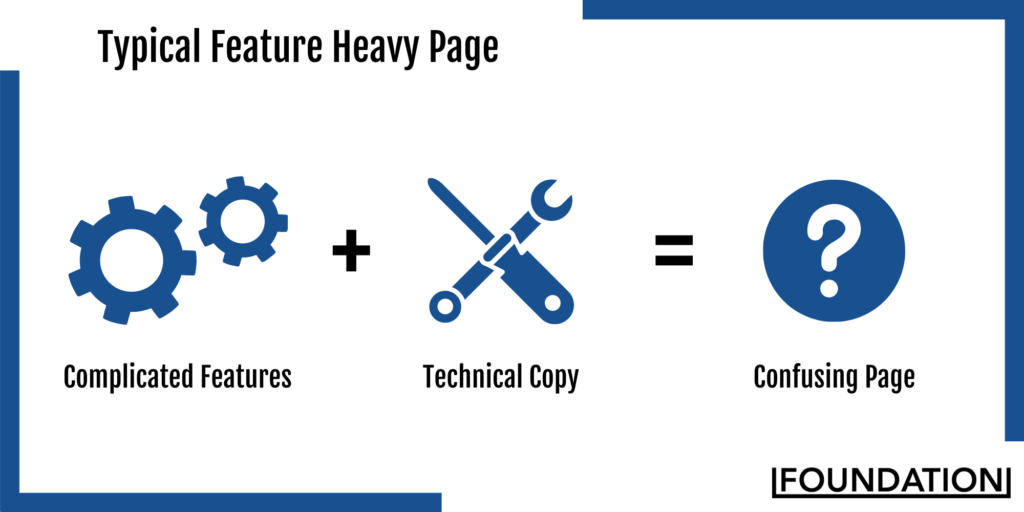
When visitors land on such a page, they get frustrated at some point because instead of finding answers, they only see more questions.
ShipBob uses social proof to sell new prospects on highly complicated features without overwhelming them. Most of ShipBob’s customers are small businesses that have zero idea how to get things shipped or how the industry works. Instead of showing off shiny product features, ShipBob lets existing customers break down complex terms for prospects, schooling them on the benefits of choosing the product.
Here’s what the formula looks like:

When a prospect lands on ShipBob’s homepage, they first see the company’s unique value proposition in the hero section:

To be honest, the message is pretty complicated.
ShipBob uses a blend of different social proofs to educate prospects on the value of their product:
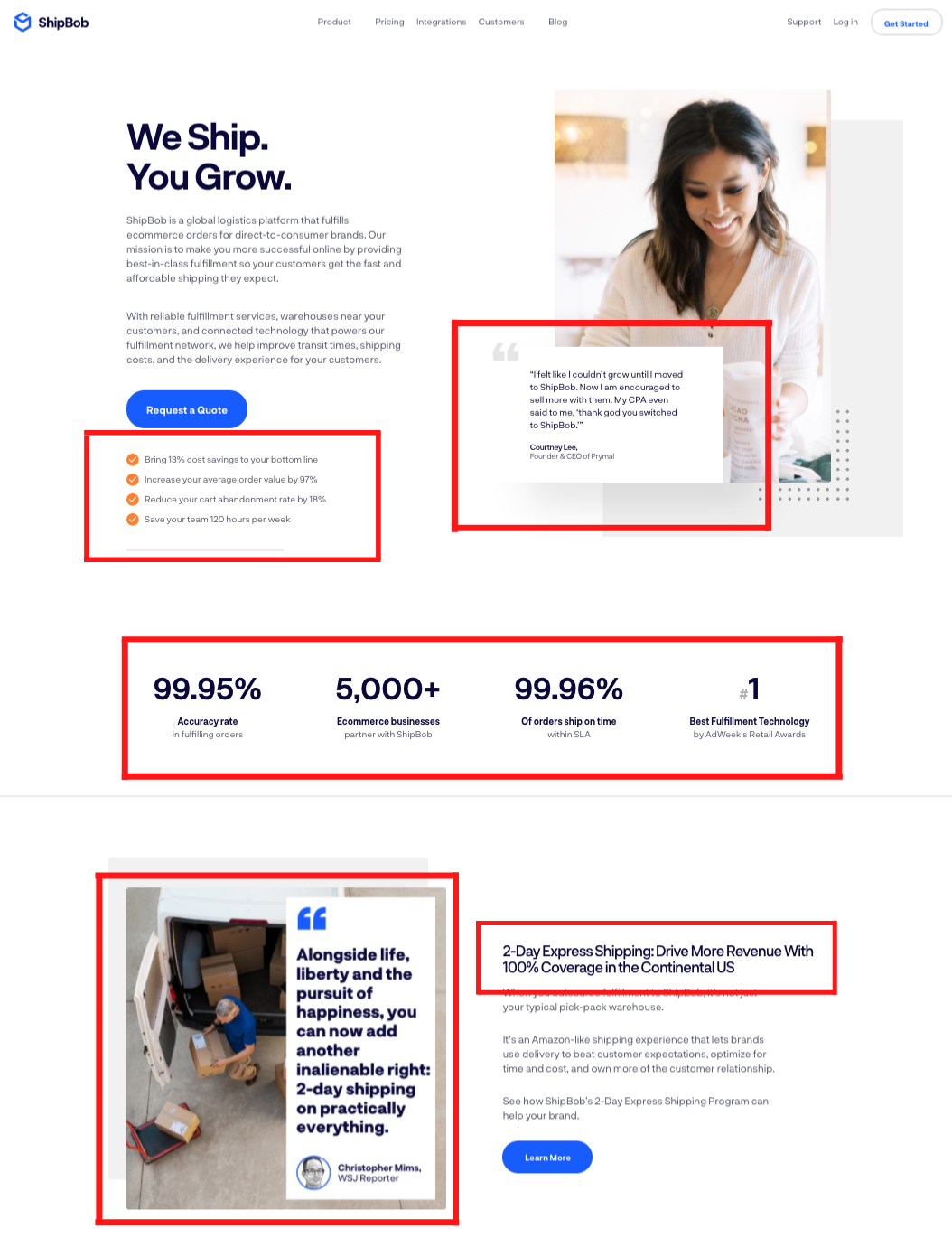
These examples of social proof break down complicated industry terms and processes into captivating, relatable stories that sell prospects on the product’s value and potential outcomes. Instead of complicated features, they sell buyers on the product’s benefits to avoid overwhelming a new user.
Notice how they use lots of white space, social proof, and rich design cues in a way that makes the buyer focus more on the customer’s words and data points. The buyer can easily connect with the story and picture themselves succeeding rather than struggle to understand complex industry jargon.
When key decision-makers from these small businesses see the results other reputable small businesses have gotten from trusting ShipBob, they are compelled to take action. The same goes for bigger brands. That’s why 5000+ e-commerce businesses rely on ShipBob.
In a nutshell, the social proof process looks pretty much like this:
The right social proof formula ignites trust at every stage of the B2B sales funnel. With the right formula in place, you can win over prospects quicker than you would with the traditional sales funnel.
Want to Steal ShipBob’s Social Proof Strategy? Download this checklist!
By downloading this resource, you’ll also start receiving a few emails per week on B2B growth and content marketing
How ShipBob Uses Social Proof at Each Sales Funnel Stages
ShipBob’s social proof formula helps the brand establish a powerful emotional connection with its customers at every stage of the sales funnel:
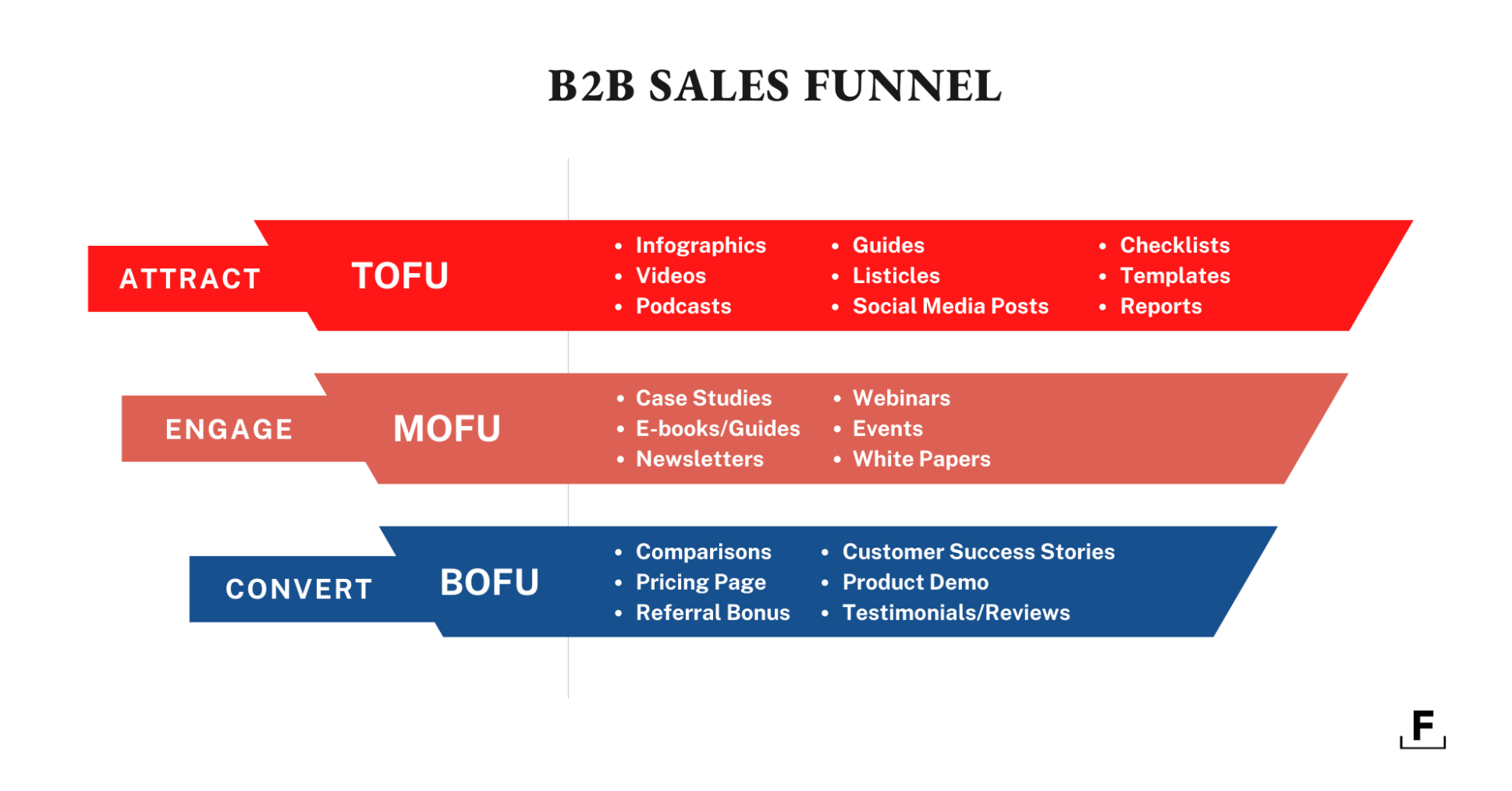
Let’s explore each stage in detail:
Top of the Funnel
For instance, at the top of the funnel, the brand builds trust by sharing major wins on social media, like this one:
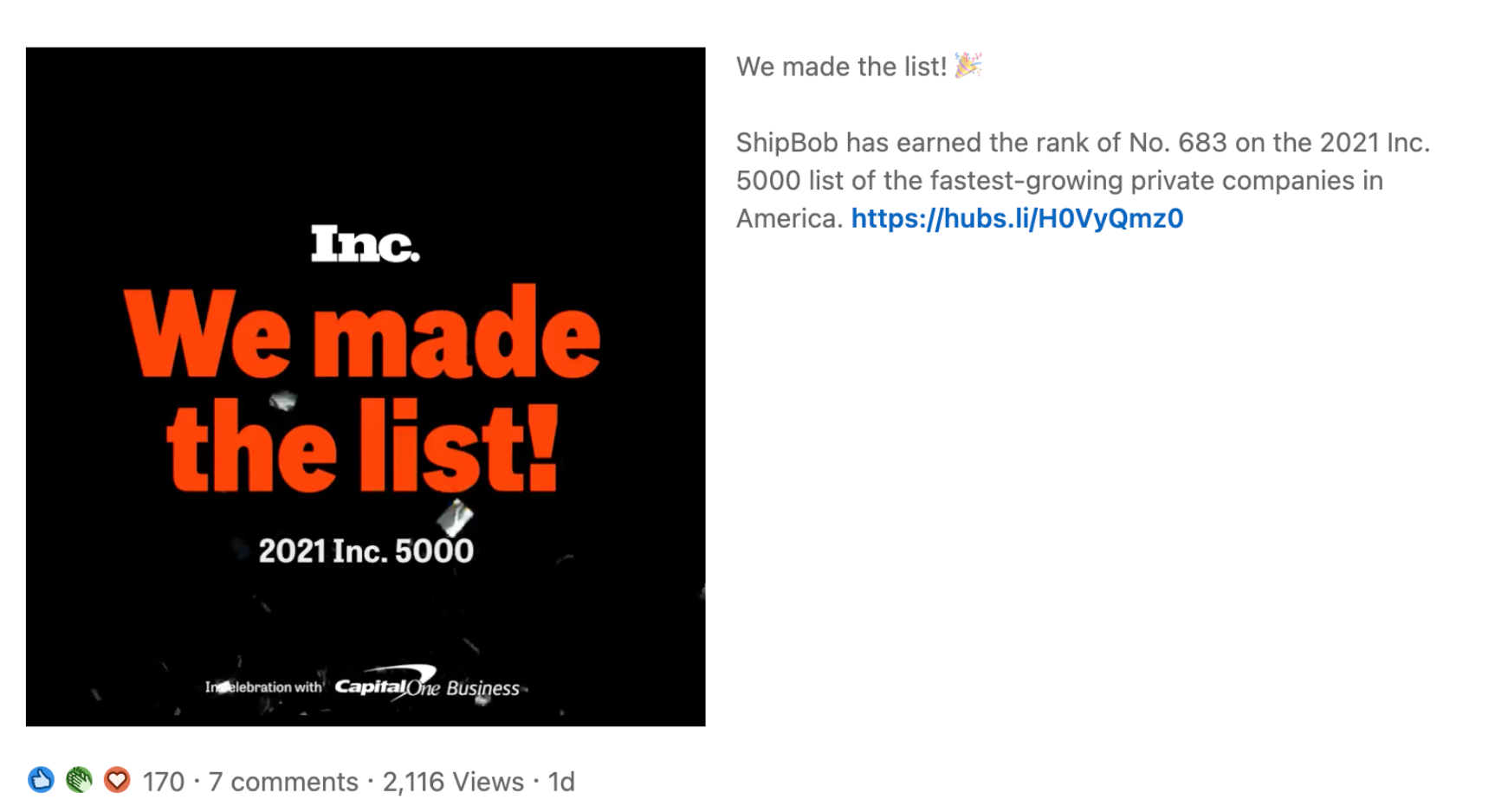
This content addresses how prospects become familiar with ShipBob.
The company’s spot on the Inc 5000 list of fastest-growing private companies in America positions it as an authority in the industry. It shows that many e-commerce brands already trust ShipBob to handle all things logistics and that the company has results to show.
So, even if someone doesn’t know what ShipBob does, seeing the company on the list with familiar brands can pique their interest in learning more about the brand. When they land on the website, they can see content that helps them learn more about their problem and understand them better.
Middle of the Funnel
At the middle of the funnel, the prospect is considering several solutions to identify the best fit now that they better understand their problem.
ShipBob nurtures leads using a variety of unique social proof points. The company features video testimonials, quotes, and case studies on significant landing pages to demonstrate customer success—for example:
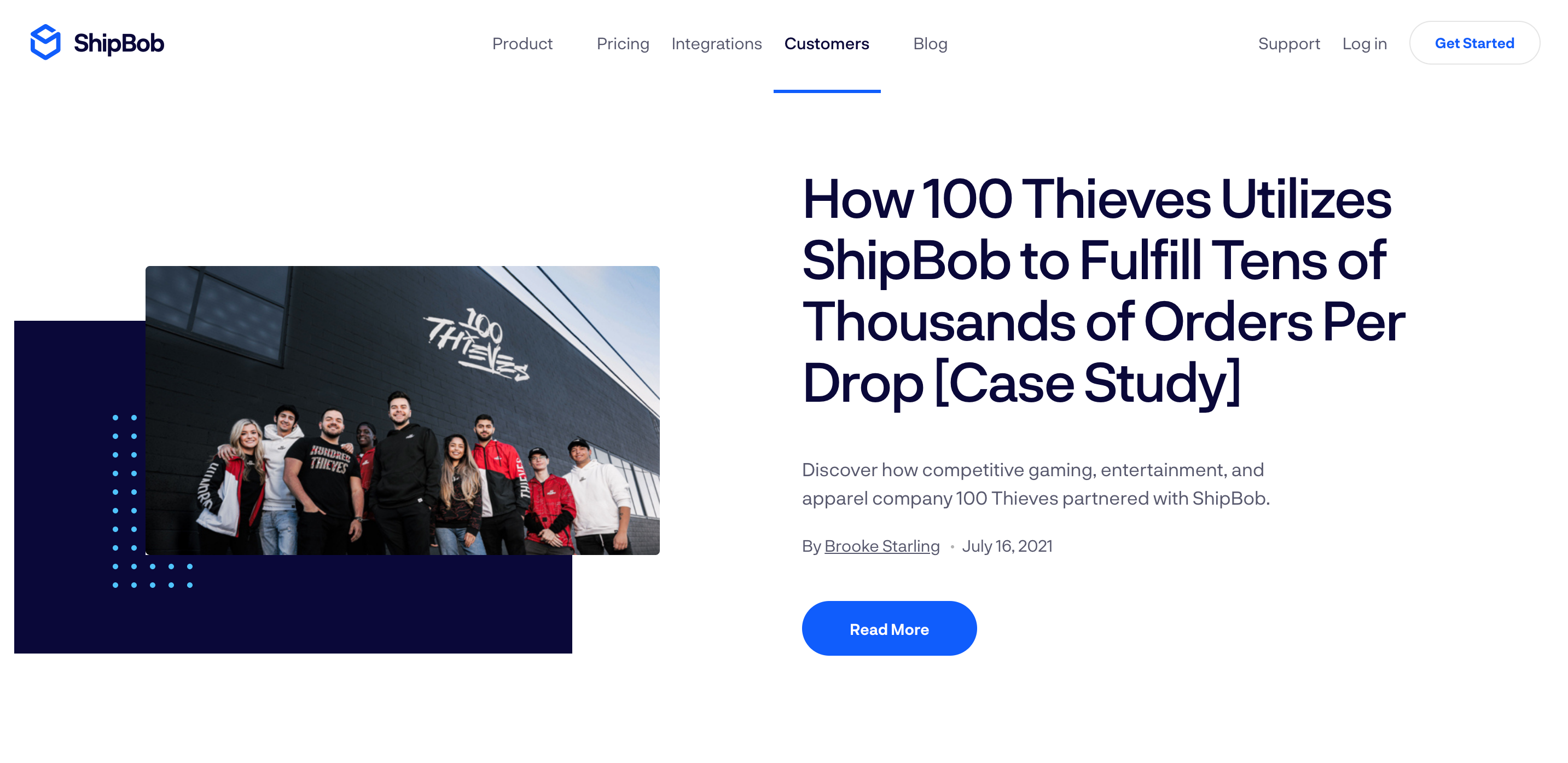
This thorough case study goes beyond telling prospects that ShipBob understands their problem. Instead, it highlights specific pain points prospects are experiencing and shows how ShipBob solved a similar problem for a company in the same industry. This content elevates ShipBob’s authority by featuring real brands, some of which the prospect might already know.
Bottom of the Funnel
At the bottom of the funnel, ShipBob stands out by adding testimonials on the pricing page:
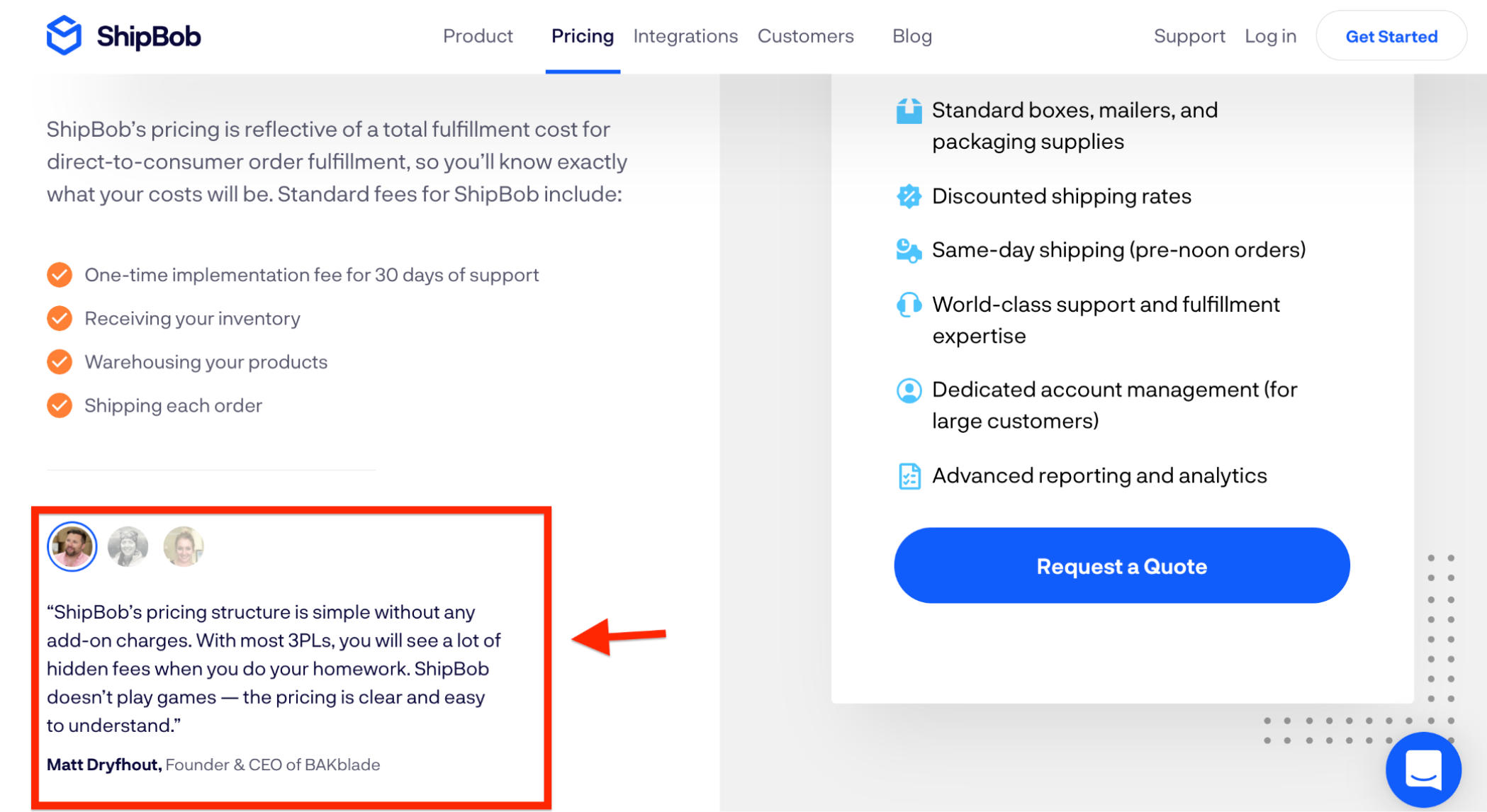
At this stage of the journey, the buyer has done enough research, enough to trust the company. However, they still want some validation that their decision will be a good one. So they are looking for pricing info and any confidence boosters to give them one last nudge.
That’s why customer testimonials come in handy on a pricing page.
Research shows that 92% of consumers read online reviews and testimonials when considering a purchase. Customer testimonials are a powerful way to build trust, show credibility, and boost conversions. ShipBob relies on the sincere voice of its customers to boost prospects’ confidence in the company. It gives leads one more reason to quit overthinking and take action.
8 Ways ShipBob Uses Social Proof
Social proof’s value across the funnel means that it’s important to integrate proof points wherever possible. For ShipBob, that includes:
1. Written User Testimonials & Quotes
Research by Nielsen revealed that 92% of people would trust a recommendation from a peer, and 70% of people would trust one from someone they don’t even know.
Written user testimonials are commonly used as a tool for connecting with prospects and providing social proof that boosts confidence in your product/service. This type of social proof can be used at all sales funnel stages to create awareness, inspire trust, and influence buying decisions.
ShipBob uses testimonials and quotes throughout its website. These testimonials humanize ShipBob’s technical process, making it easy for visitors and prospects to understand its value proposition and user benefits.
Let’s take the testimonial in the hero section of ShipBob’s homepage, for instance:
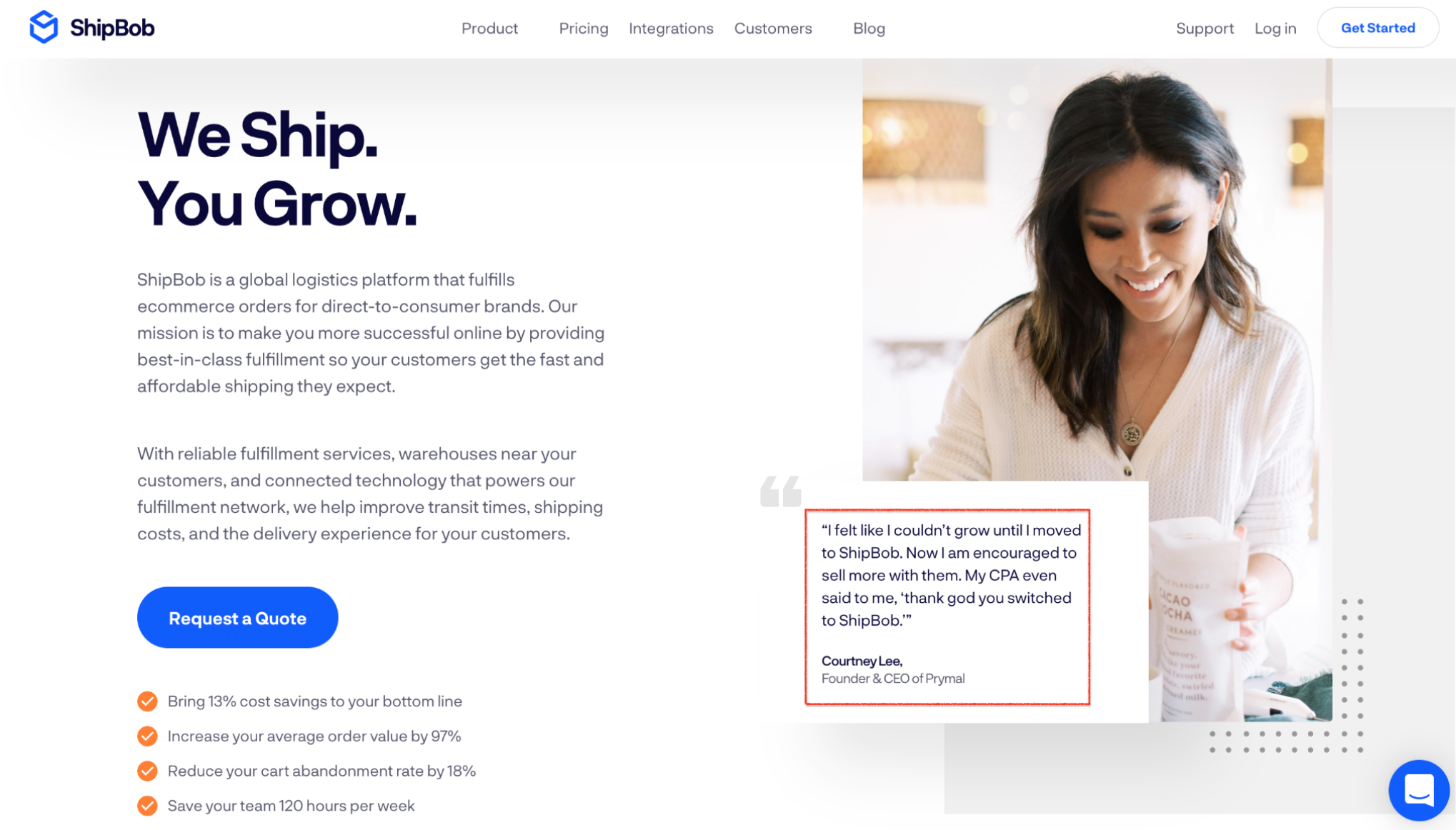
Notice how the main headline and body copy focus on ShipBob’s mission and features. As you can see, they use hard-to-understand industry terms that make it difficult for prospects to understand the product’s value to their business.
The easy-to-read testimonial, however, brings this section to life. What makes the testimonial so powerful is its structure, including the name, title, organization, quote, and a happy headshot of an existing customer.
Here’s another example from ShipBob’s product page:
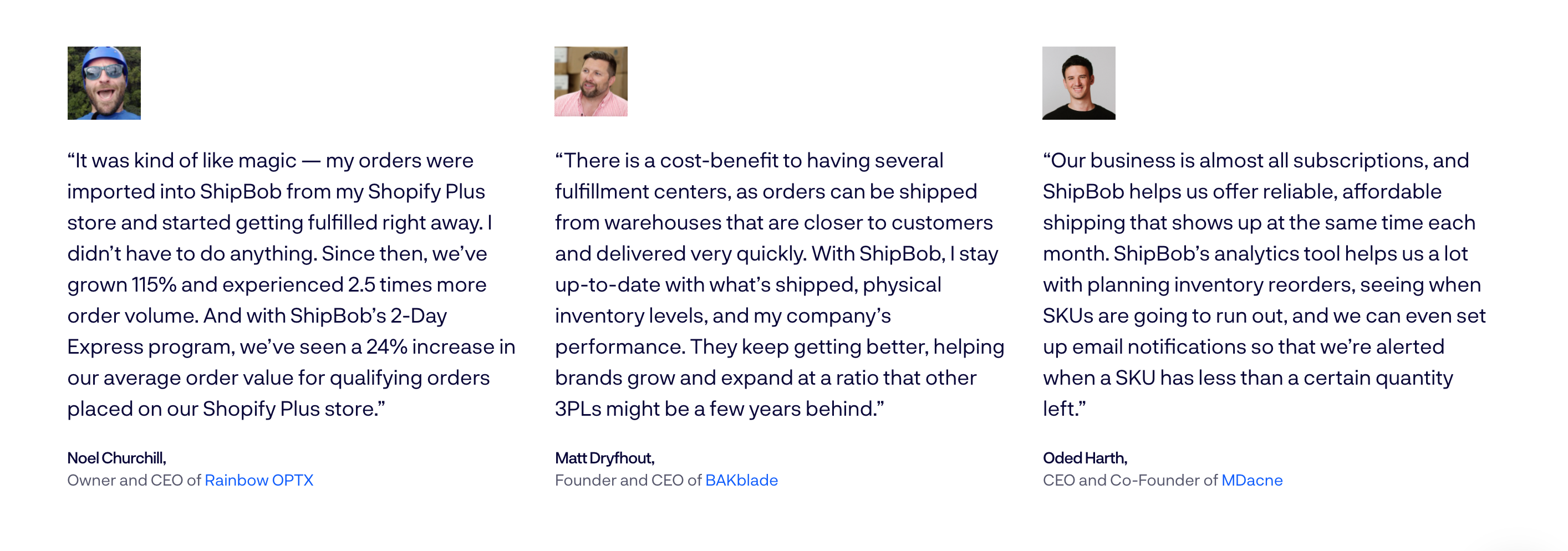
Notice how ShipBob adopts the same format, including headshots that show customers smiling. Research has shown that including photographs makes customer testimonials more believable. A smiling picture shows buyers that the customers are real people smashing their goals with ShipBob as a trusted partner.
How You Can Use Testimonials & Quotes
You can use customer testimonials and quotes to earn prospects’ trust and build credibility. Ask your customers for feedback. You can make it easy for them to submit a testimonial by sending over questions via email or using a survey form. Encourage them to include data points that show how your product has helped scale their business.
2. Customer Video Testimonials
Case studies, user reviews, and testimonials are great tools for building credibility. However, investing in customer video testimonials is an even better way to go.
We’ve got some stats to prove it:
- 2 out of 3 people say they’d be more likely to purchase after watching a video testimonial demonstrating how a business, product, or service had helped another person like them.
- 59% of executives say they would rather watch a video than reading text
- 72% of customers would instead learn about a product or service by way of video.
ShipBob has a library of compelling video testimonials:
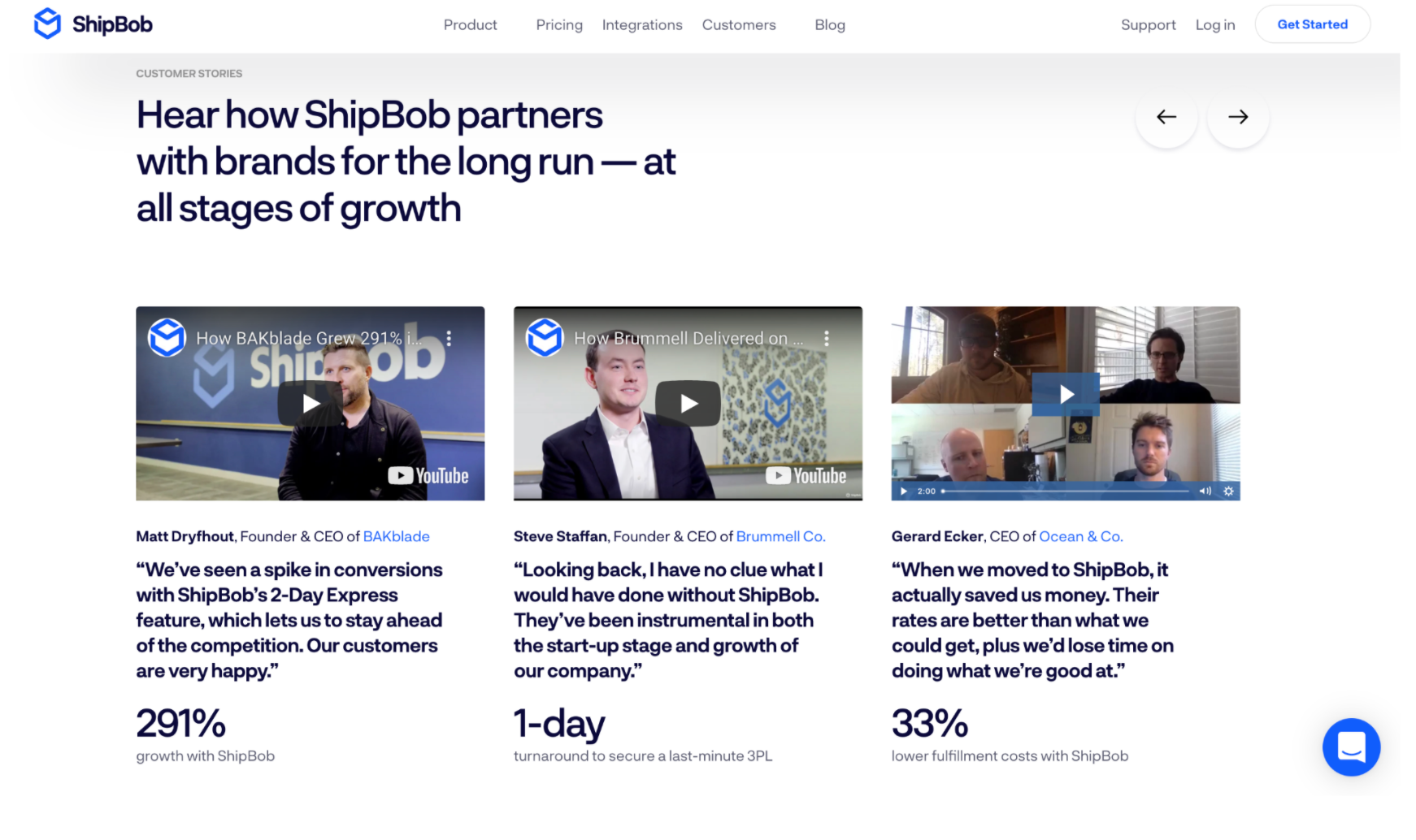
It features key players within partner companies and includes the executive’s name, position, and organization’s name.
These video testimonials are so powerful because they highlight clear, specific, and measurable results. They also play a significant role in the middle of the funnel—the consideration stage of the buyer’s journey.
Take BAKblade’s story, for instance:
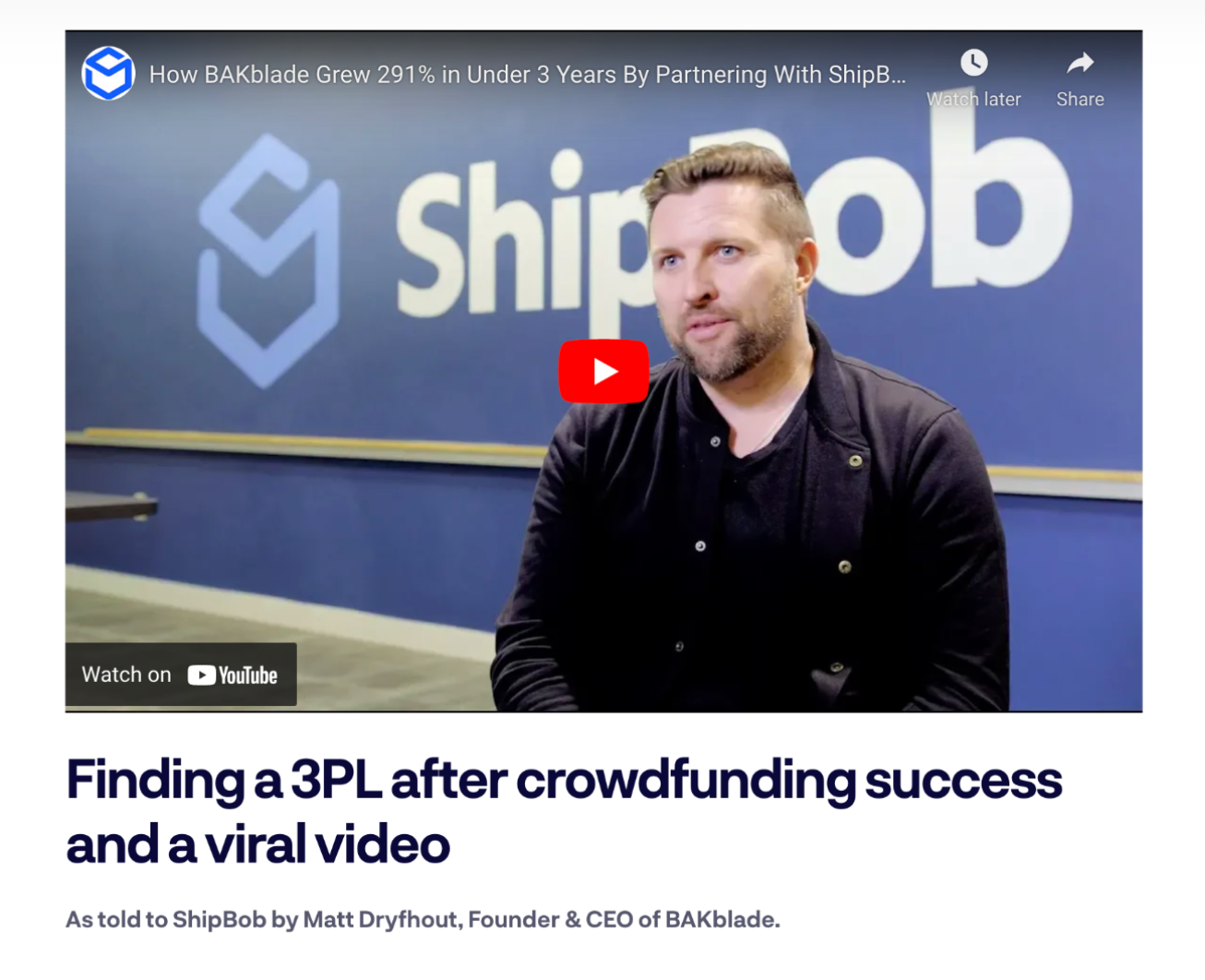
The founder and CEO, Matt Dryfhout, shares how the company grew by 291% in under three years while partnering with ShipBob. Matt shares how a crowdfunding and viral video generated thousands of orders they weren’t prepared to fulfill. After a long search, they found a partner in ShipBob.
One thing that stood out in Matt’s story was the benefits his company, BAKblade, enjoyed after deciding to partner with ShipBob.
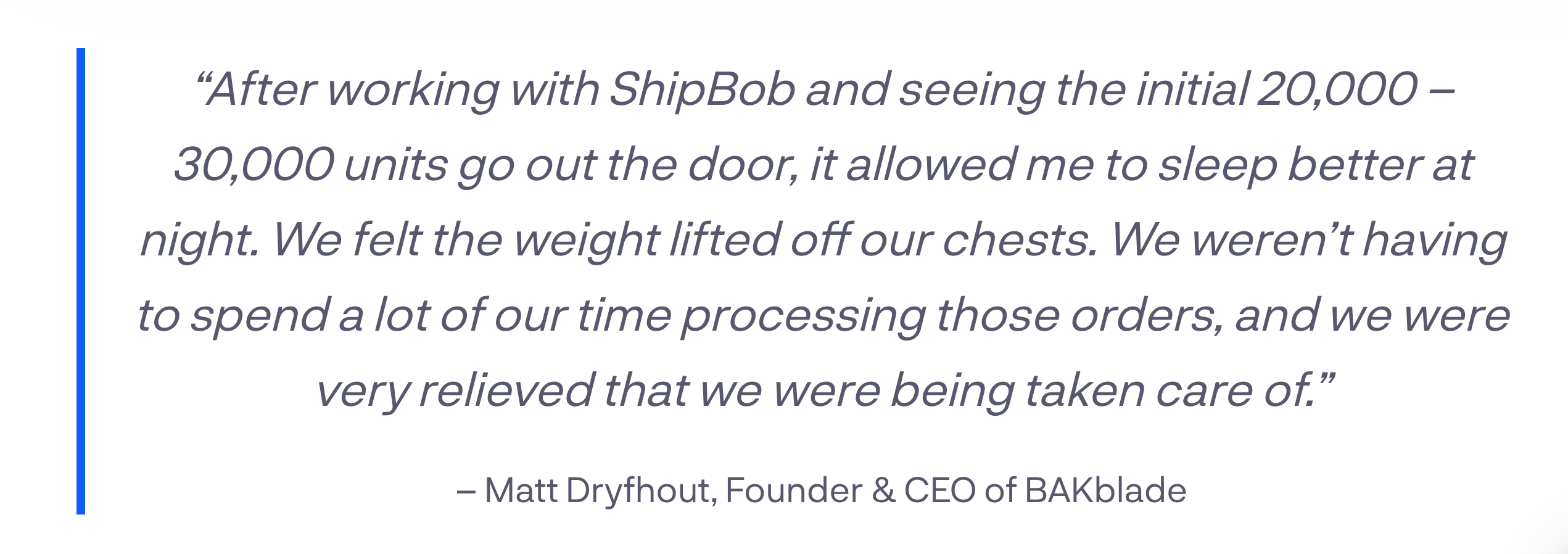
Prospects can better understand product benefits when they hear the customers’ narrative, which allows them to imagine how much their business can grow if they partner with ShipBob.
These success stories show ShipBob in action and give the buyer tangible reasons why they should choose the company over competitors. Even better, these prospects can watch the videos without leaving the company’s website.
How You Can Use Video Testimonials
You can use video testimonials on your landing pages and case studies to engage prospects better. To create engaging videos, you can send an email to customers or give them a call to know if they are willing to record a testimonial. Offer to interview them. Customers may feel more comfortable answering specific questions on camera than recounting their experience without any questions to guide their thoughts.
3. Webinars Featuring Experts
B2B audiences love webinars and conferences, and ShipBob doesn’t ignore this fact.
ShipBob nails webinars by collaborating with experts in the industry. The Operator Series, for instance, lets DTC leaders share their knowledge of industry-related topics. Recently, the company hosted Neil Callahan, the president of Greats, for their operator webinar series:

Collaborating with these experts lets ShipBob tap into the guest’s expertise and influence. It positions ShipBob as a reliable authority and distributor of relevant, helpful content, allowing its audience to learn from other experts in the industry.
How You Can Use Expert Webinars
You can use webinar software to share educational content and insights from case studies or to feature industry experts sharing their expertise with your audience.
When prospects see a familiar face and brand, they are more likely to attend the webinar. You can start with identifying industry experts and influencers whose mission aligns with yours and reach out to ask them to be a guest on your next webinar. Be sure to highlight how this collaboration can benefit their brand as well as your audience.
4. Case Studies
In the B2B world, 69% of content marketers use case studies to educate prospects about the benefits of their products and services.
Like video testimonials, case studies help prospects in the middle of the funnel see why they should choose you over competitors. Using your customers’ words, you can show prospects the customers’ problems, the step-by-step process used to solve those problems, and the outcomes.
ShipBob has a dedicated section for case studies where they highlight customer success stories:

Take the case study on TB12, for instance. ShipBob tells a compelling story about the health and wellness brand’s growth. The brand uses personalized B2B storytelling, combining qualitative and quantitative results.
The headline shows the exact (or estimated) results TB12 got from trusting the logistics company:

Apart from the headline, ShipBob also incorporates a section called “key metrics” in which they share the company’s results.

Michael Peters, the VP of E-Commerce Operations, shares the full story on how beneficial the company’s partnership with ShipBob has been.
For busy prospects, ShipBob highlights vital benefits and data points across the piece in the form of quotes and subheadings.
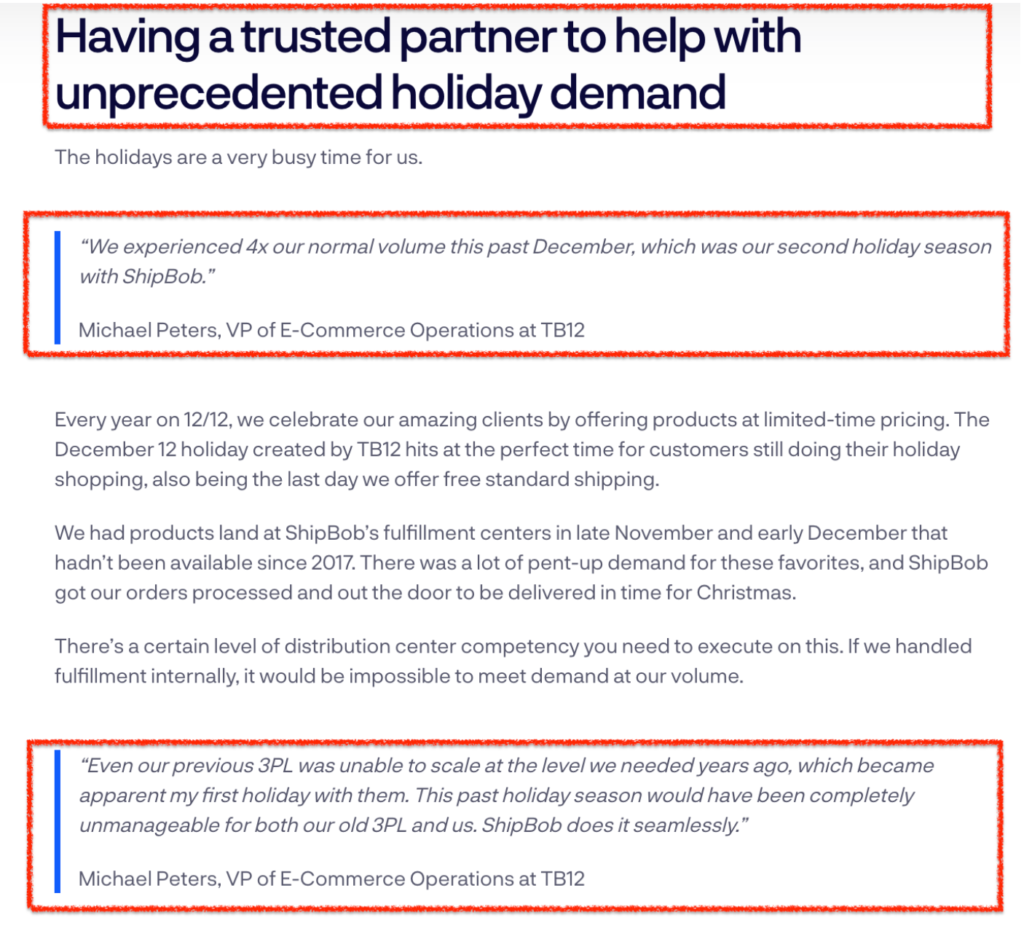
ShipBob follows up the compelling story with a powerful Call-To-Action (CTA), boosting their chances of converting prospects directly from a single content piece instead of relying on the long traditional sales funnel.
The customer success stories section has over 40 stories like TB12’s. These in-depth, relatable stories prove that customers became successful after trusting ShipBob.
How You Can Use Case Studies
You can build a library of customer success stories for your product/service. Identify one or more customers you’ve had great success with, reach out to them via email or other channels to see if they’d be willing to share their progress. If they agree, draft some preliminary questions and send them along. You can use these case studies on landing pages, marketing emails, social media, etc.
5. User Reviews and Ratings
User reviews and ratings let users express their feelings towards a product/service using a numerical rating and a few words. This type of social proof can be used at all stages of the funnel. ShipBob has a page dedicated to user reviews and ratings rounded up from trusted review websites:
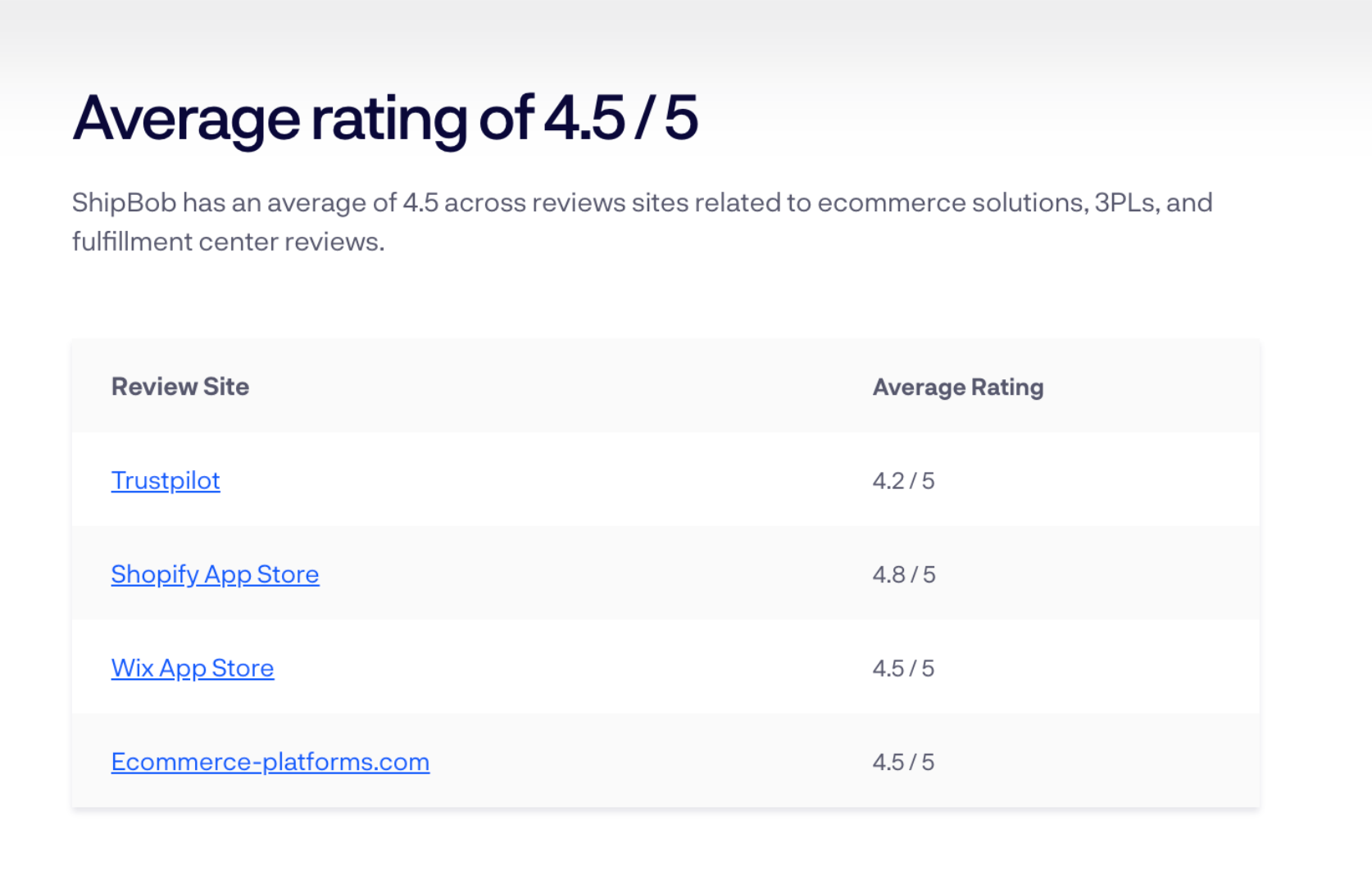 These reviews from credible sites like Trustpilot make it easy for prospects to make a buying decision. A 2020 study validates our position. 63% of consumers say they are more likely to purchase from a site if it has good product ratings and reviews.
These reviews from credible sites like Trustpilot make it easy for prospects to make a buying decision. A 2020 study validates our position. 63% of consumers say they are more likely to purchase from a site if it has good product ratings and reviews.
ShipBob also displays reviews from these rating platforms, like this one from E-commerce-platforms.com.
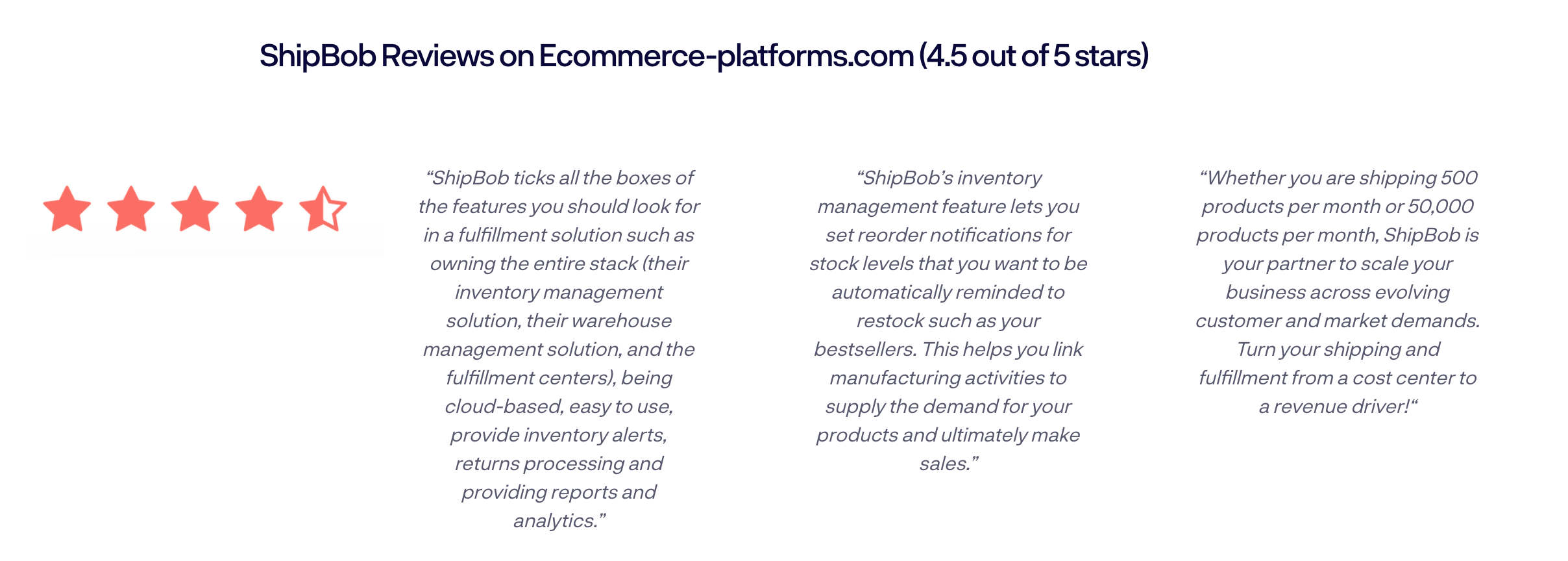
These reviews show ShipBob’s product in action. Notice how the highlighted review breaks down ShipBob’s inventory management feature in a simple, benefit-driven comment. The reviewer shows buyers how they can manage their inventory better with ShipBob, and how doing so can boost sales and customer satisfaction.
How You Can Use Rating & Reviews
You can point customers to trusted sites like G2 and Trustpilot to leave a review for your products, after updating your product info on these platforms. Feature the most relevant reviews on your website. You can create a dedicated landing page like ShipBob or infuse them into different landing page copies on your website. That way, customers can see these reviews several times at different stages of the funnel.
6. Partner Logos
Displaying partner logos is another social proof tactic ShipBob uses. These logos are typically used at the bottom of the funnel, specifically on sales pages.
ShipBob has a page dedicated to these partners, showing different integrations and their different purposes, like the company’s freight management and shipping integrations.
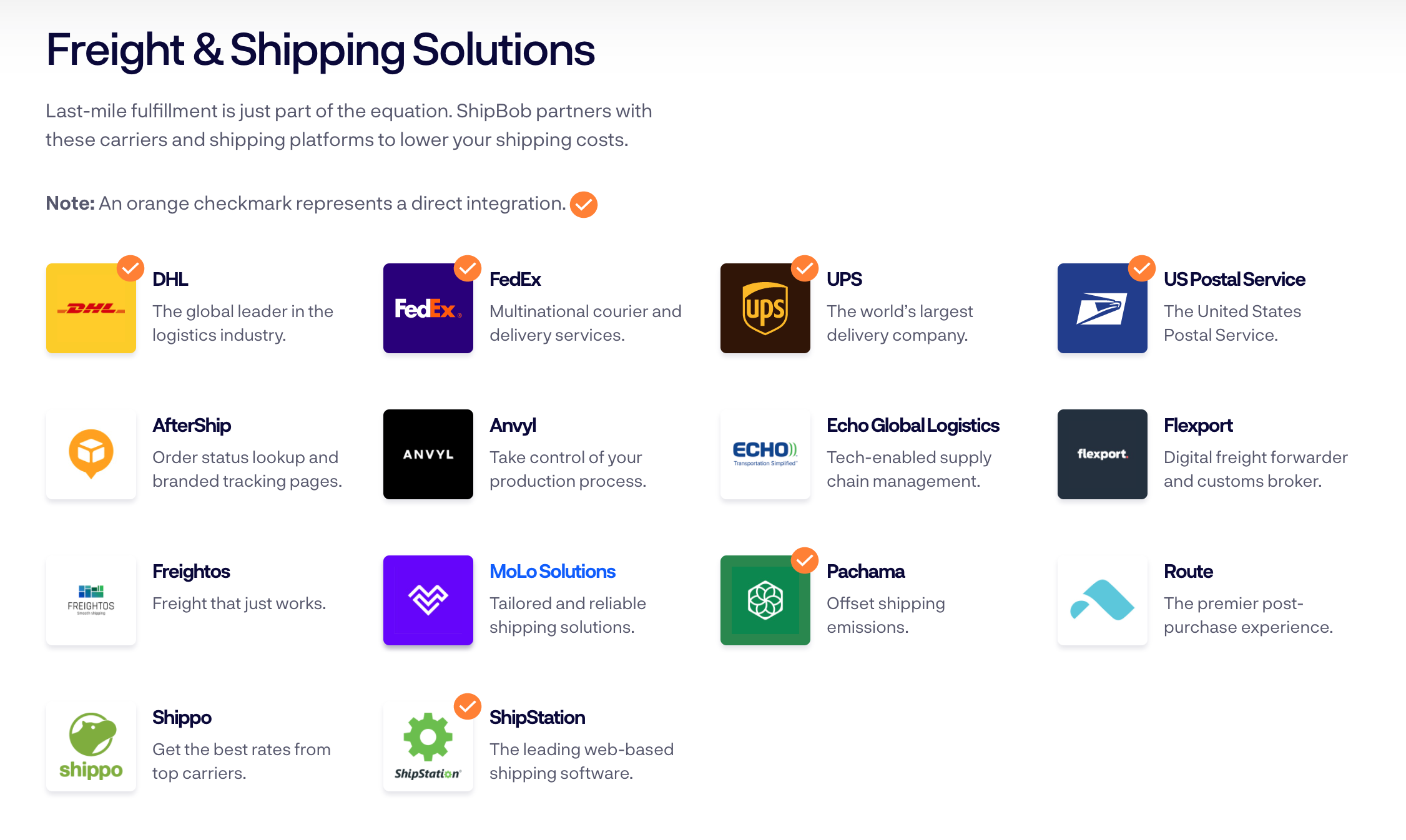
Another example is their list of ecommerce platform integrations.
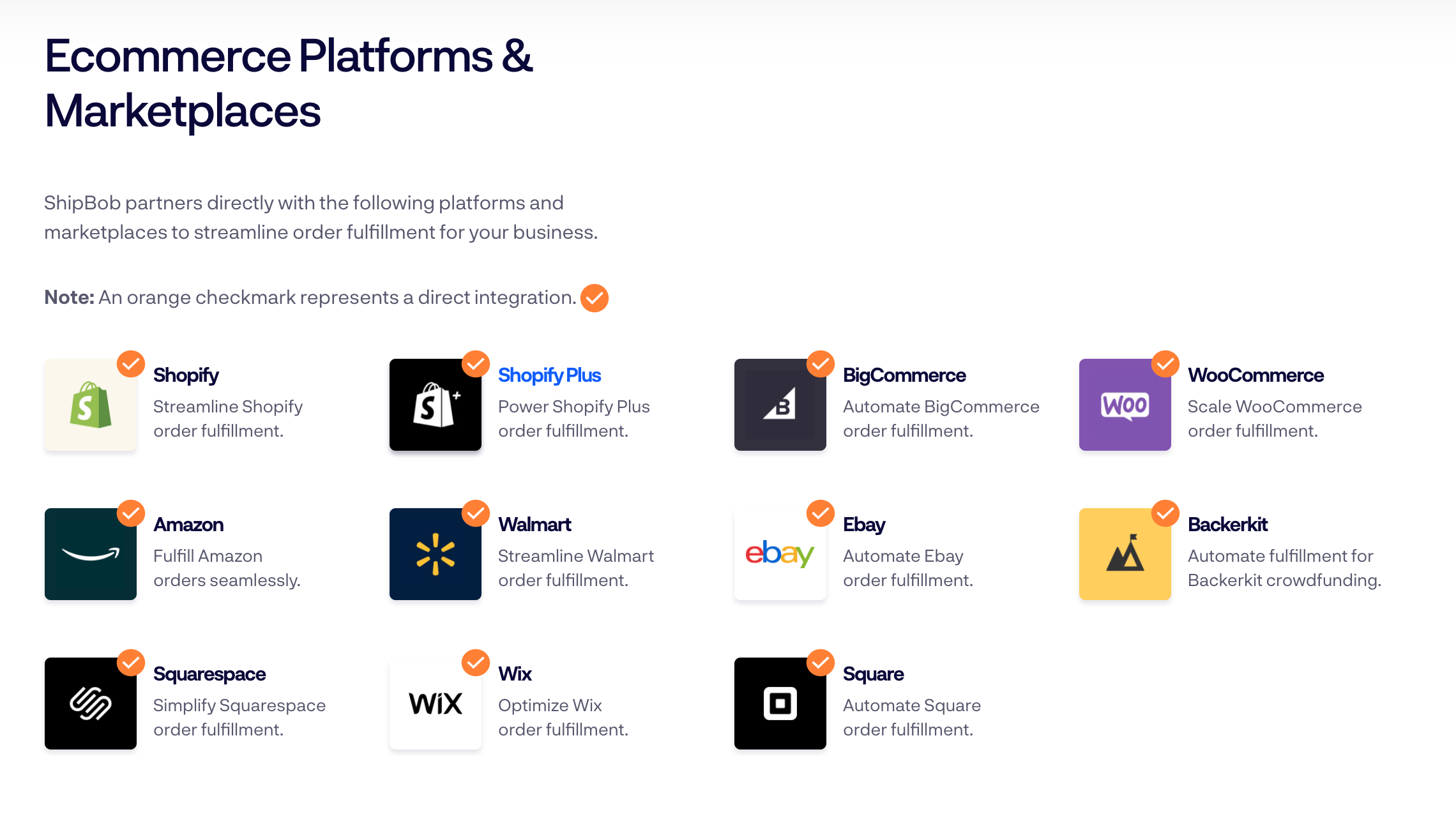
When visitors show up to the website, even though they aren’t familiar with ShipBob, seeing a familiar brand like Amazon, Squarespace, Wix, eBay, etc., is likely to boost ShipBob’s credibility in their eyes.
How You Can Use Partner Logos
You can adopt this strategy for your brand. Showcase the logos of your partners, especially the giants in the industry. But you do need their permission first. Place these logos on your home page, sales landing pages, and even the pricing page. When your customers see you are affiliated with a brand they trust, they are more inclined to trust you.
7. News Mentions
ShipBob promotes their news features to boost their credibility:
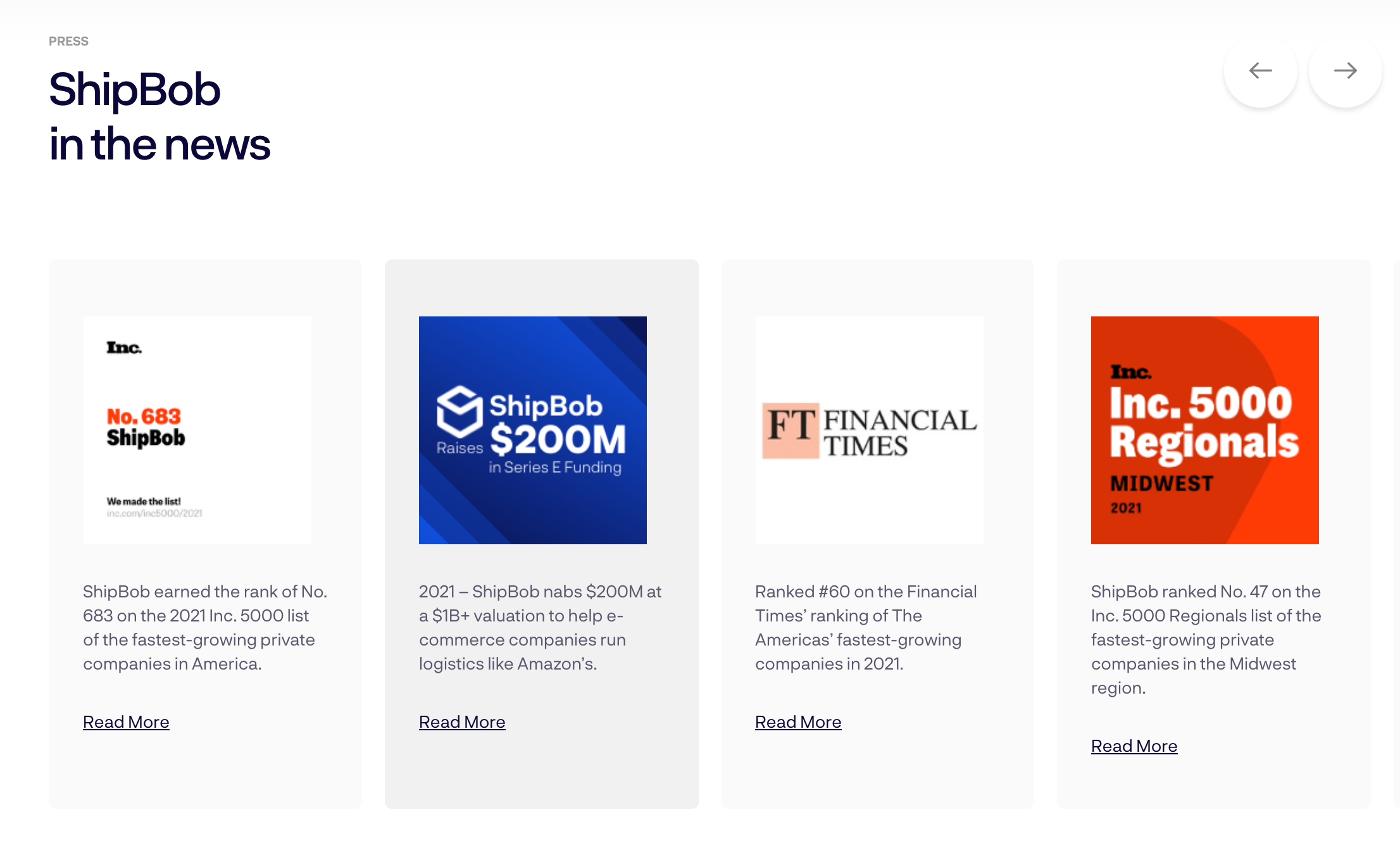
Getting featured on a high-authority website like Fast Company gives ShipBob exposure and credibility in the eyes of potential buyers.

Techcrunch’s feature on ShipBob’s fresh $200M funding that boosted their e-commerce valuation to $1B positions ShipBob as a success in the eyes of prospects:
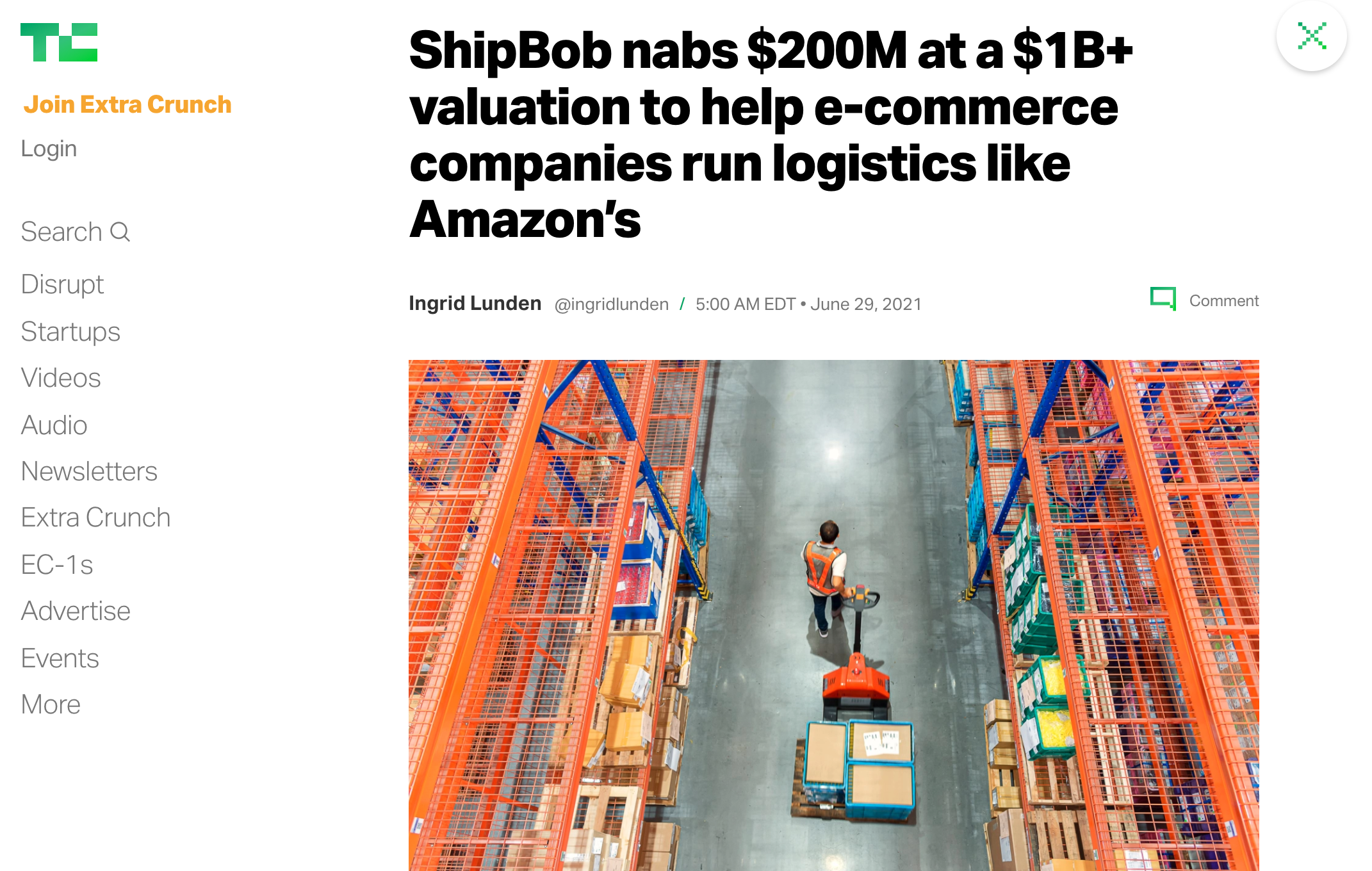
News like this has a way of increasing prospects’ confidence in their decision to partner with the company. If the company is successful, it means they are more likely to be successful in working with them.
How You Can Use Press Mentions
You can also feature authority sites where your product was mentioned on your website and social media. If you haven’t been mentioned anywhere yet, you can work towards growing your media/press visibility.
8. Raw Data and Awards
Numbers tell a strong story in their own way. They give a brand bragging rights. ShipBob flaunts its achievements on its website in many forms. One of the ways they do so is by sharing raw data in highlights like this feature on their landing page:

These numbers assure ShipBob’s 600K+ monthly organic visitors that other businesses have used the product and hit their fulfillment goals.
AdWeek’s Retail Awards mentions ShipBob as the #1 Fulfillment Technology.
Notice that ShipBob didn’t crown itself king. They focused on meeting customer needs and earned a high-authority media award that they can now flaunt.
ShipBob also uses raw data in case studies to show customers’ progress.
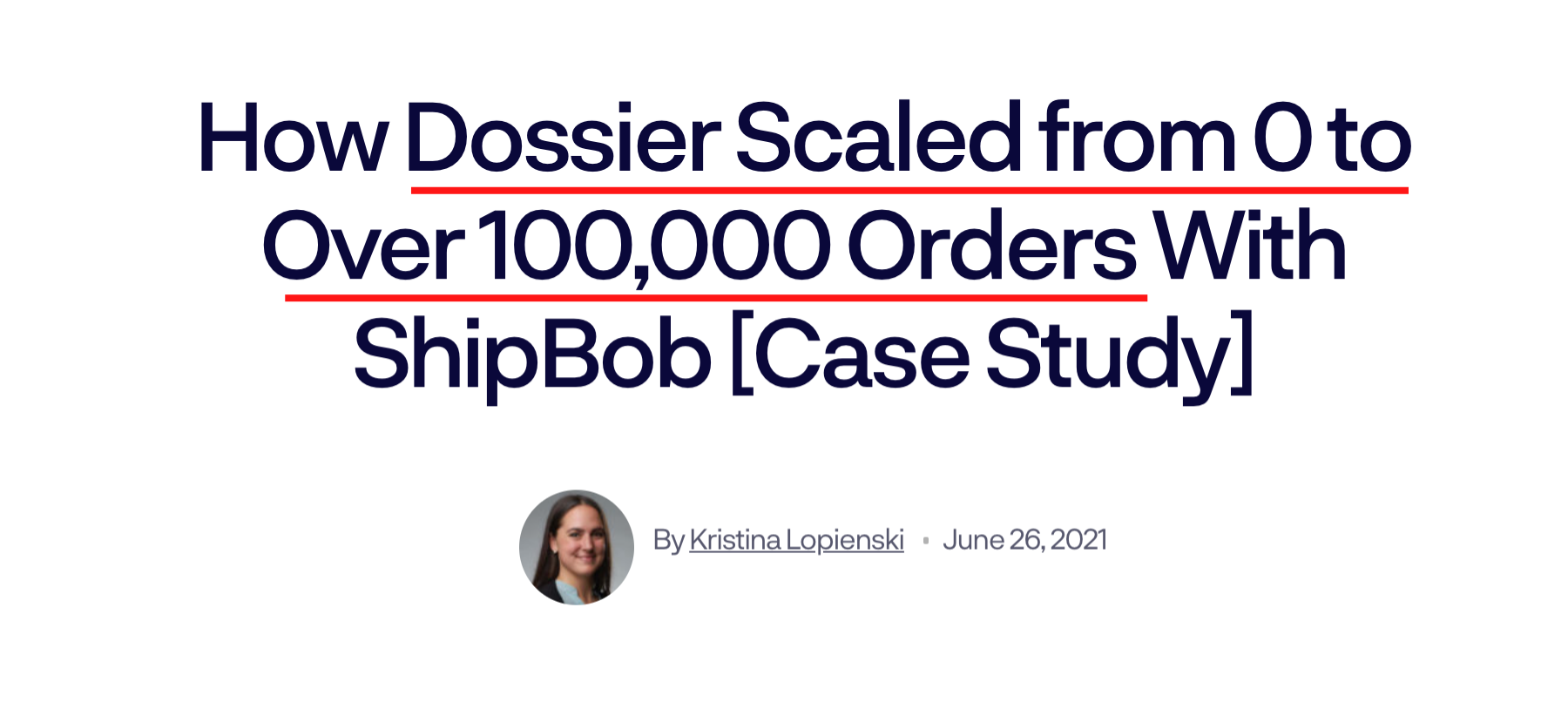
How You Can Use This Tactic
You can adopt this tactic by using impressive stats like the number of customers/users, certifications, awards, quantitative customer results, and other numbers you think prospects would like to see.
Wrap Up
ShipBob leveraged the power of social proof to build trust, establish credibility, and earn the loyalty of over 5000 e-commerce businesses.
Rather than rave about product features, ShipBob lets the customers—those who have experienced the product firsthand—tell compelling transformation stories.
You can apply ShipBob’s social proof formula to your B2B, SaaS, and e-commerce brand. You won’t get similar results in a day. However, with some patience, consistency, and attention to other vital areas, you’ll be well on your way to getting impressive results.
Stay up to date with all of our latest findings by subscribing to our newsletter today. Signing up also gives you early access to Ross’ Tuesday essay full of exclusive industry insights.
Quick, do it now before the next drop!








